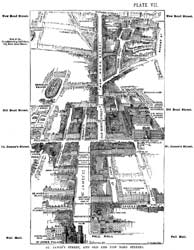Issue 5 : Hound, Chapters 5 and 6
| Holmes and Watson visit the art
galleries located along Old Bond Street, at the center of the map |
|
…and he was entirely absorbed in the pictures
of the modern Belgian masters. He would talk of nothing but art, of which
he had the crudest ideas, from our leaving the gallery until we found
ourselves at the Northumberland Hotel.
Several different schools of Belgian painters were active in the late
19th century. James Ensor (1860-1949), arguably the most famous,
was a maverick who painted on macabre themes and anticipated the symbols
of Expressionism. Of the Symbolist painters, Fernand Khnopff (1858-1921)
is probably the best known. Others painted in a naturalistic style, depicting
workers and peasants at their labors.
Watson occasionally mentions Holmes's ignorance of all things that do
not touch on detective work:
In later stories, Holmes no longer seems to be quite so ignorant, but actually has a good knowledge of many disciplines that do not touch upon criminal activities, especially music.His ignorance was as remarkable as his knowledge. Of contemporary literature, philosophy and politics he appeared to know next to nothing. Upon my quoting Thomas Carlyle, he inquired in the naivest way who he might be and what he had done. My surprise reached a climax, however, when I found incidentally that he was ignorant of the Copernican Theory and of the composition of the Solar System. That any civilized human being in this nineteenth century should not be aware that the earth traveled round the sun appeared to me to be such an extraordinary fact that I could hardly realize it.
—from A Study in Scarlet, chapter 2
…and when he did speak it was in a much broader and more Western dialect than any which we had heard from him in the morning.
Apparently, Sir Henry Baskerville's American accent grows stronger when he is upset.
"Seems to me they are playing me for a sucker in this hotel," he cried. "They'll find they've started in to monkey with the wrong man unless they are careful. By thunder, if that chap can't find my missing boot there will be trouble. I can take a joke with the best, Mr. Holmes, but they've got a bit over the mark this time."
Conan Doyle loved American "wild-west" adventure stories, and they might have been his major source of knowledge about American slang expressions. In this passage, he makes the most out of Sir Henry's use of American slang, mixing it with Briticisms such as "chap" and "they've got a bit over the mark." Perhaps he was trying to show that Sir Henry's character had been formed by exposure to two cultures: his upbringing in Devon and his later experiences in North America.
"Seven hundred and forty thousand pounds."
Holmes raised his eyebrows in surprise. "I had no idea that so gigantic a sum was involved," said he.
This grand sum equals more than three-quarters of a billion dollars in today's currency.
"James Desmond is an elderly clergyman in Westmoreland."
Westmoreland is found in Northern England, quite a distance from Devonshire.
"He would be the heir to the estate because that is entailed."
Used in former days to prevent the breakup of large estates by inheritance, entailment limits the right of succession of property to a specific group of heirs, usually keeping it in the male line of direct decent.
"…we shall meet at the 10:30 train from Paddington."
Paddington is the terminus of the Great Western Railway, and lies about a mile and a half west of Baker Street.
"…I spent it at the Museum of the College of Surgeons."
The Museum of the Royal College of Surgeons would be a natural attraction for Dr. Mortimer, considering his interests. It featured an enormous collection of preserved specimens from human and animal dissections performed by John Hunter (1728-1793), fossils, medical instruments, and more. The government purchased it in 1799, and today it can still be visited. For a small glimpse of its vast holdings, see: www.rcseng.ac.uk/museums.
…a wagonette with a pair of cobs was waiting.
A wagonette, as its name implies, was an open wagon with side benches—rather more rustic than any conveyance Watson would have been used to in London. Cobs are sturdy draft horses, used for farm work.
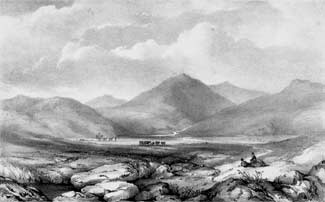 …heavy with dripping moss and fleshy
hart's-tongue ferns. Bronzing bracken and mottled bramble gleamed in the
light of the sinking sun.
…heavy with dripping moss and fleshy
hart's-tongue ferns. Bronzing bracken and mottled bramble gleamed in the
light of the sinking sun.The parts of Devon not covered by the moors support lush vegetation. On the moors, an over-abundance of water soaking into the peaty soil creates the dangerous mires.
The moor is not as sinister as it appears in The Hound of the Baskervilles. At right, a pastoral scene on the moor includes grazing sheep and cattle, a hay wagon, and, in the foreground, some picnickers.
A Perambulation of the Ancient and Royal Forest of Dartmoor, by Samuel Rowe, Vicar of Devon, published in 1848, includes etchings of some of the archeological and geological attractions to be found on the moor.
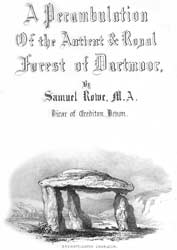 |
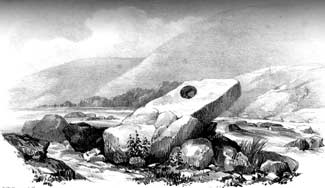
At left, a tolmen (or dolmen), a simple burial chamber; above, a fallen tolmen |
|
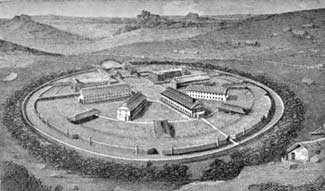 |
A 19th-century
view of Dartmoor Prison |
"There's a convict escaped from Princetown, Sir."
Dartmoor Prison was founded at Princeton, on Dartmoor, in 1809 to house prisoners of war. Conditions in the prison during the 19th-century were notorious, and there was a high mortality rate. Escapes were not uncommon. The difficulties of recapturing prisoners on the foggy moor are described in A.J. Rhodes, Dartmoor Prison (1933).
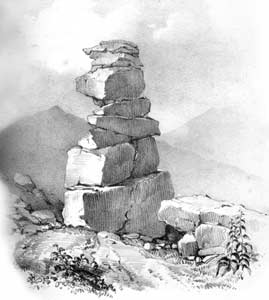 |
A cairn with
a tor in the background |
"Cairn" is a loose term for a pile of stones, usually marking an ancient burial place. A "tor" is a natural granite outcropping on the moor, exposed by years of weathering. Granite bedrock lies under the moor, keeping water from draining away, so that the ground remains saturated.
"…with a thousand candle-power Swan and Edison right here in front of the hall door."
Thomas Alva Edison (1847-1931) and Joseph Swan (1838-1914), as well as other inventors, worked simultaneously on designs for an incandescent light bulb. Swan patented his design 10 years earlier than Edison. Edison, savvier at marketing than Swan, dominated the British and American markets until he was finally forced by the courts to merge his British operation with Swan's. Fitting the Victorian idea of a stereotypical American, Sir Henry turns to technology to fix the gloomy, menacing atmosphere of Baskerville Hall. Unfortunately, Sir Henry's straightforward character and positive attitude go hand-in-hand with a certain naïveté and an inability to comprehend things beyond his limited experience.
…crenellated, and pierced with many loopholes.
A "crenellated" tower has battlements for archers to shelter behind. "Loopholes" are small openings for surveillance or shooting. Both are relics of Baskerville Hall's medieval past.
A dull light shone through heavy mullioned windows….
"Mullioned" windows are common in Gothic architecture, where the "mullion," or vertical divider between windows, is usually made of stone.
…and heavily raftered with huge balks of age-blackened oak.
"Balks" are large, crude beams.
…behind the high iron dogs….
Fireplace "dogs" are stands used for hanging cooking pots at the fire.
A dim line of ancestors, in every variety of dress, from the Elizabethan knight to the buck of the Regency…
Between 1811 and 1820, the future King George IV ruled as Regent for his father, George III, who suffered from periodic insanity. The Regency was known as a hedonistic and dissolute time. The young "buck" would have been dressed in flamboyant clothing, with curls and a wide-brimmed hat.
